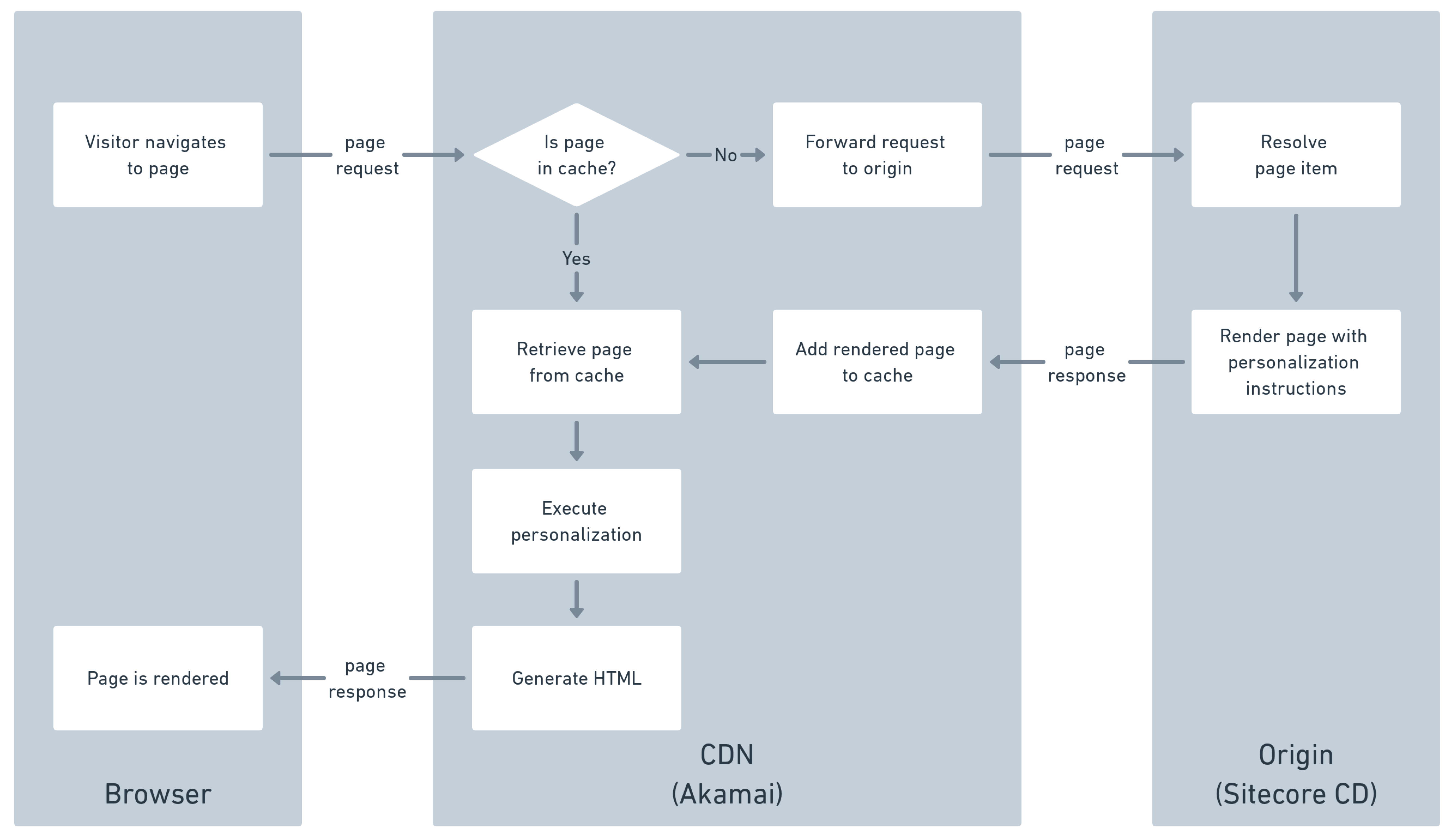Akamai
The purpose of using Akamai as a CDN is to reduce the need for
a Sitecore CD instance to handle visitor requests. The first
time a page is requested, Akamai must request the page from
the origin (i.e. Sitecore CD instance). But all subsequent
requests for the page can be handled by Akamai CDN.
The following diagram illustrates the logic that results in a personalized page being delivered to a visitor.

Uniform Optimize provides the ability to purge entries from the Akamai cache. This is necessary when content in Sitecore changes. By purging the pages in Akamai cache, Akamai is forced to retrieve the latest content from Sitecore.
Akamai API client#
In order to purge entries from the Akamai cache, Uniform Optimize must make API calls to Akamai. The settings that Optimize uses to connect to Akamai are specified in a Sitecore config file.
Details on how to create the required config file are available in the installation instructions. The purpose of this section is to describe the configuration options that are available and how API clients are used.
Configuration#
An API client is the collection of settings that Uniform Optimize uses to make API calls to Akamai. The settings can be broken down into the following categories:
Connectivity#
Connectivity settings are used to establish the connection between Uniform Optimize and Akamai. These values are generated by Akamai during the installation process. These settings include:
- Access token
- API URL
- Client secret
- Client token
Selection#
Uniform Optimize uses selection settings to identify which parts of the Akamai cache to purge. These settings include:
- Network - In Akamai, a property has separate settings for staging and production. This setting identifies which of those networks cache purge instructions are sent to.
- Host name - When Uniform Optimize sends to Akamai a list of URLs to purge, it also sends one-or-more host names so that Akamai can locate the appropriate cache entries.
- CP codes - In Akamai, each property is represented by a CP code. This setting identifies the Akamai property that is associated with the API client.
Assignment#
Uniform Optimize uses assignment settings to determine which API client to use when a cache purge request is made. These settings include:
- Sites - Each API client can be assigned to one-or-more Sitecore sites. The site is identified by its name.
Resolution#
When cache purge is triggered, a Sitecore item is identified as the root item.
The Sitecore site that the root item is a part of is determined. The first API client assigned to the Sitecore site is used. If no API client is assigned to the Sitecore site, an error is thrown.
note
If the cache purge was triggered manually, the error message is displayed. If the purge was triggered by publishing, the error is written to the Sitecore log.
Cache purge operations#
A cache purge operation represents the act of purging entries from the Akamai cache. There are two kinds of cache purge operations.
Full-site purge#
Purging all URLs for a site is called "full-site purge".
How is full-site purge triggered?#
Full site purge is triggered in the following ways:
- "Publish site" command is triggered
- Automated purge for an item based on the template "Uniform Site Item"
- Manual purge for an item based on the template "Uniform Site Item"
note
Triggers that involve publishing require the setting "Clear Akamai cache on publish" be enabled.
How are cache entries selected?#
The cache entries that are purged depend on whether CP codes are specified on the API client:
- CP codes specified - All cache entries associated with the specified CP codes are purged.
- No CP codes specified - Dependent pages are resolved for the root item of the Sitecore site and its descendants.
Item purge#
Purging the URLs for a site based on the "root item" is called "item purge".
How is item purge triggered?#
Item purge is triggered in the following ways:
- Automated purge for a content item.
- Automated purge for a media item.
- Manual purge for a content item.
- Manual purge for a media item.
note
Triggers that involve publishing require the setting "Clear Akamai cache on publish" be enabled.
How are cache entries selected?#
The specific URLs that are purged are determined by the process that resolves dependent pages.
Dependent pages#
When cache purge is triggered for an item, Uniform Optimize must determine the URLs related to that item in order to send the appropriate purge instructions to Akamai.
Imagine that you have changed an item that represents a banner that appears on multiple pages on your site. Those pages are called "dependent pages", because they depend on the banner item. Uniform Optimize must resolve the URLs for the dependent pages, because those are the URLs that must be purged from the Akamai cahche.
Dependent pages are resolved by the pipeline getPurgeItems.
The result of this pipeline running is a collection of items.
The URLs for these items are sent to Akamai to be purged.
By default, the following items are added to the collection:
- Root item - The root item is provided in the args passed to the pipeline. This item represents the item that was published or was selected to be purged.
- Descendants - The pipeline args includes a property "clear cache option". If this is set to "clear item branch cache", the descendants of the root item are included.
note
Related items are not included out-of-the-box. If you need related items to be included, you must add a custom pipeline processor that implements the required functionality.
You can add processors to this pipeline to include additional items based on your site design and information architecture.